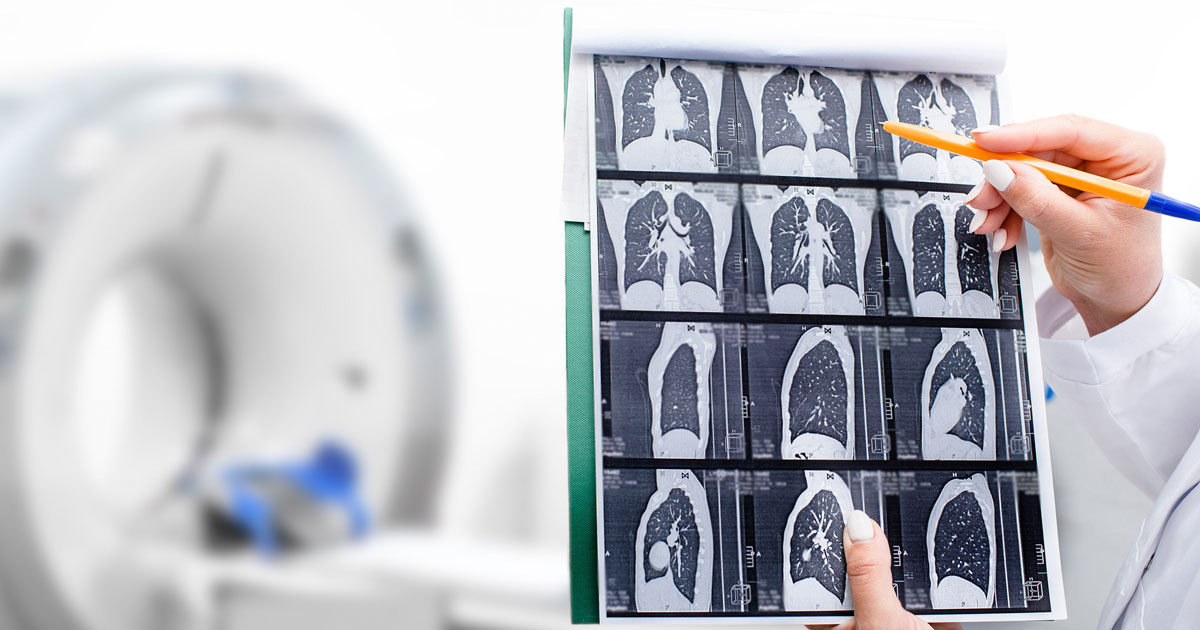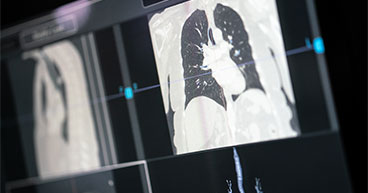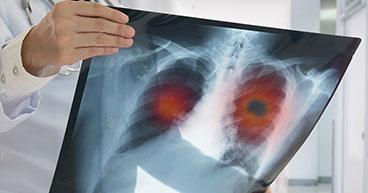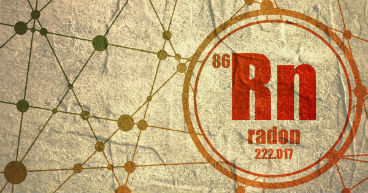
If you’ve been a smoker for many years, it’s not enough to just quit the habit to reduce your risk of lung cancer. Heavy smokers remain at increased risk for cancer years after they quit lighting up. That’s why it’s important for those at high risk to take advantage of annual screenings with a low-dose computed tomography (CT) scan, which has been shown to help detect lung cancer early, when more treatment options are available.
Lung cancer is the leading cause of cancer death in America, according to the National Cancer Institute. Patients have a longer life expectancy when the disease is caught early, the American Society of Clinical Oncology says. The five-year survival rate for patients whose lung cancer hasn’t spread is about 63 percent, compared with 7 percent for those whose cancer has metastasized.
Low-dose CT scans are designed to detect suspicious spots or nodules on the lungs in asymptomatic patients, helping doctors determine whether further tests are needed. The scans produce high-quality, 3D-like digital pictures of areas inside the body. The images are composed of X-ray “slices,” layered one upon another to obtain a detailed image that can be used to detect small abnormalities.
A National Lung Screening Trial in 2011 found that heavy smokers who’ve received this screening test had a 20 percent lower chance of lung cancer death than participants who received standard chest X-rays.
“Everyone who’s eligible should be getting them,” says Jason Beland, MD, Chair for the Department of Radiology with City of Hope Atlanta, Chicago and Phoenix. “If you detect lung cancer at an early stage, patients may see more positive outcomes with the appropriate treatment. That’s what makes it an important test.”
In this article, we‘ll explain:
- Who's eligible for screening?
- Preparing for a low-dose CT scan
- Getting your results
- How many years will you need to have scans done?
- What does a low-dose CT scan show?
- Why not use a regular CT scan?
- Low-dose CT scans at City of Hope
If you’re at high risk for cancer and are interested in learning more about screening for lung, breast or colorectal cancer at City of Hope, call us or chat online with a member of our team.
Who’s eligible for lung cancer screening?
The U.S. Preventive Services Task Force (USPSTF) recommends annual screenings for current and former smokers, ages 50 to 80, who are smoking—or who’ve quit within the previous 15 years—and have at least a 20 pack-year smoking history. The USPSTF recently lowered the minimum age for screening from 55 to 50 and the pack-year history from 30 to 20.
Health insurance or Medicare typically cover the cost of the procedure for people who meet the eligibility criteria, Dr. Beland says.
Preparing for a low-dose CT scan
A LDCT scan is a painless and relatively quick outpatient procedure performed in a hospital, clinic or medical facility equipped with imaging technology. If your health care provider determines you meet the criteria, he or she will write a prescription for a scan.
Here’s what to expect:
You won’t have any diet restrictions to follow before a scan is performed, and you can resume your normal activities as soon as it’s finished.
You’ll want to leave jewelry, piercings or other metal accessories at home, or you’ll have to remove them before the screening.
It may be chilly. You may be asked to remove your shirt, blouse and/or bra and wear a hospital gown during the procedure. Though the equipment doesn’t require special cooling, medical facilities tend to be on the colder side.
Don’t worry about claustrophobia. “If we think of an MRI machine as a tube, a CT scan would be a donut,” Dr. Beland says. “Your whole body is not all the way into the machine as it is for an MRI.”
The procedure should only take a few minutes. The technician will have you lie flat on the scanner table, which will move you in and out of the scanner. The technician may do a practice run to calibrate the CT machine to your body features before administering the test.
When the scan is being done, you’ll be asked to hold your breath for short intervals, about 5 to 10 seconds at a time, to get the clearest images possible.
Even though current smokers are eligible for routine scans, they’re also encouraged to enter a smoking cessation program. The screening process often includes regular visits to a doctor to assess the patient’s lung health and check for smoking-related conditions.
“There are any number of smoking-related illnesses, such as emphysema, oral cavity cancers, other issues that may be teased out,” Dr. Beland says. “Embedded in the comprehensive approach is a relationship with a health care provider who’s asking the appropriate questions.”
Getting your results
Your test images may be read by a radiologist the same day, and you’ll typically receive your results the next day. Many exams come back negative, with no abnormalities, but don’t be overly alarmed if yours doesn’t. Remember, the exam won’t tell you whether you have cancer, only if there are abnormalities in the lungs that require further investigation.
“One of the common concerns of screening is the anxiety of waiting for the results and getting an abnormal result,” Dr. Beland says. “Another is what we would call false positives—finding things that aren’t lung cancer and the anxiety, monetary costs, follow-up examinations, biopsies, etc., that come from those things.”
Doctors rely on an examination score to determine further steps that may need to be taken. The score, which can range from 0 to 4, is called a Lung-RADS assessment. The scores are broken down this way:
- 0: Incomplete—part or all of the lungs could not be evaluated.
- 1: Negative—only definitely benign nodules or no nodules were found.
- 2: Benign appearance or behavior—there’s a very low likelihood of nodules becoming cancerous.
- 3: Probably benign—shorter-term follow-up is suggested.
- 4A: Suspicious—additional diagnostic testing is recommended.
- 4B/4X: Very suspicious—additional testing and/or tissue sampling is recommended.
“Small lung nodules are very common, particularly in smokers,” Dr. Beland says. “It’s not uncommon to find things. That’s also why the Lung-RAD assessment makes it very, very clear what the follow-up is.”
How many years will you need to have scans done?
The low-dose CT scans for lung cancer screenings are only recommended for those between the ages of 50 and 80, and only for up to 15 years following the time you stop smoking. A heavy smoker who quits at the age of 45 would be eligible for screenings from age 50 to 60, while a smoker who quits at age 40 would be eligible between the ages of 50 and 55.
Also, no matter your age or how long it’s been since you quit, your doctor may have you continue the screenings or recommend other procedures if recent scans have shown worrisome abnormalities.
How often should you get a low-dose CT scan?
The LDCT screenings are typically performed annually, but they may be given in three- or six-month intervals based on previous scan results.
What does a low-dose CT scan show?
The low-dose scans for lung cancer screenings are designed to work because your doctor is looking for specific warning signs of possible lung cancer, such as spots or nodules, that may appear in the lungs. This early detection process uses less radiation to find these abnormalities than if the scans were being used to detect changes in bones or denser matter.
“We only need to see things in the lungs, and therefore, we can decrease the dose that we’re delivering.” Dr. Beland says. “The dose that we would use for a lung-cancer screening CT wouldn’t help if we were looking at an abdomen, or a liver, or a kidney or a problem in those areas, because you’re not getting enough tissue contrast.”
The low-dose CT screenings are designed for high-risk patients who exhibit no symptoms of lung cancer and are not a diagnostic tool used for someone suspected of having cancer.
“When we’re doing a diagnostic scan, not a screening scan, for a patient with a problem—they come in with chest pain, they come in with shortness of breath, they come in with a metastatic cancer or potentially metastatic cancer—that’s a problem that we’re trying to diagnose, not an asymptomatic patient that we’re screening,” Dr. Beland says. “We need to have enough quality in the imaging that we’ve obtained to be able to answer not only whether there’s a lung nodule, but whether there are any other potential abnormalities.”
Why not use a regular CT scan?
Any type of cancer screening that involves radiation comes with the potential of increasing cancer risk. So doctors want to expose their patients to as little radiation as possible. The low-dose CT scan produces about four to five times less radiation than a typical diagnostic CT scan.
A diagnostic scan uses about 7 millisieverts (mSv) of radiation, compared with only 1.4 mSv for a low-dose scan, according to the Agency for Healthcare Research and Quality. An mSv is the scientific unit for measuring ionizing radiation.
“It’s a tailored CT scan intended to detect lung nodules that may potentially become lung cancer,” Dr. Beland says. “Because of that, we don’t need to use higher doses to evaluate other structures such as the heart, the mediastinum, the bones, the chest wall and other things that show up on a chest CT scan.”
The amount of radiation exposure during a low-dose CT scan is less than the average background radiation most Americans are exposed to over a typical six-month span.
Because of that reduced exposure, the low-dose scan allows for more frequent exams—annually or more often—as part of a comprehensive lung cancer screening program. Regular screenings also help doctors determine whether nodules not previously considered worrisome have changed in any way that warrants further investigation.
Low-dose CT scans at City of Hope
City of Hope is certified by the American College of Radiology (ACR) to conduct these scans, and our experts will work with you if:
- You’re interested in determining your eligibility for screening.
- You want to schedule a screening.
- You already have a scanning order or referral from your personal physician.
All City of Hope hospitals are equipped for low-dose screenings, and our cancer experts will interpret your results and counsel you about them.
When you come to City of Hope for a low-dose CT scan or other cancer screenings—for breast or colorectal cancer—you'll have access to tools, some powered by artificial intelligence, that may help increase the accuracy of the screening tools provided. Our team has decades of expertise in administering these tests and procedures and interpreting their results, allowing us to work quickly and efficiently.
Regular screenings are critical to reducing your cancer risk. No matter where you get your screenings, Dr. Beland recommends making them a regular part of your wellness plan and keeping your calendar up to date with reminders, if necessary.
If you’re at high risk for cancer and are interested in learning more about screening for lung, breast or colorectal cancer at City of Hope, call us or chat online with a member of our team.



